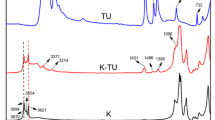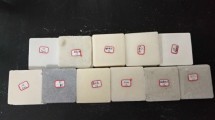Abstract
The thermal properties of paraffin as phase change material (PCM), combined with layered zinc hydroxide nitrate (LZHN) and intumescent flame retardant (IFR), have been studied by thermogravimetric analysis (TG), TG-Fourier transform infrared spectrometry (TG-FTIR), cone calorimeter (CONE),and differential scanning calorimetry (DSC). The TG results indicated that the thermal stabilities of the paraffin and paraffin/IFR composites could be improved when dodecyl sodium sulfate-modified LZHN (ds-LZHN) was incorporated. The TG-FTIR results indicated that ds-LZHN could reduce the release of combustible gases for paraffin and paraffin/IFR. The CONE results showed that the flame-retardant efficiency of IFR could be improved in the paraffin/IFR system owing to ds-LZHN. DSC results presented that the phase change temperatures and latent heats of the composites were determined by the dispersed paraffin with their mass percentage.








Similar content being viewed by others
References
Sharma A, Tyagi VV, Chen CR, Buddhi D. Review on thermal energy storage with phase change materials and applications. Renew Sustain Energy Rev. 2009;13:318–45.
Shukla A, Buddhi D, Sawhney RL. Solar water heaters with phase change material thermal energy storage medium: a review. Renew Sustain Energy Rev. 2009;13:2119–25.
Ducrocq P, Duquesne S, Magnet S, Bourbigot S, Delobel R. Interactions between chlorinated paraffins and melamine in intumescent paint—investing a way to suppress chlorinated paraffins from the formulations. Prog Org Coat. 2006;57:430–8.
Horacek H, Pieh S. The importance of intumescent systems for fire protection of plastic materials. Polym Int. 2000;49:1106–14.
Liu Y, Yi JS, Cai XF. The investigation of intumescent flame-retarded polypropylene using poly(hexamethylene terephthalamide) as carbonization agent. J Therm Anal Calorim. 2012;107:1191–7.
Sarannya V, Sivasamy P, Mathan ND, Rajkumar T, Ponraju D, Vijayakumar CT. Study of thermal properties of intumescent additive. J Therm Anal Calorim. 2010;102:1071–7.
Wang JC, Yang K, Zheng XY. Studies on the effect of 4A zeolite on the properties of intumescent flame-retardant agent filled natural rubber composites. J Polym Res. 2009;16:427–36.
Xia Y, Jian XG, Li JF, Wang XH, Xu YY. Synergistic effect of montmorillonite and intumescent flame retardant on flame retardance enhancement of ABS. Polym-Plastic Technol. 2007;46:227–32.
Wu ZP, Shu WY, Hu YC. Synergist flame retarding effect of ultrafine zinc borate on LDPE/IFR system. J Appl Polym Sci. 2007;103:3667–74.
Fontaine G, Bourbigot S, Duquesne S. Neutralized flame retardant phosphorus agent: facile synthesis, reaction to fire in PP and synergy with zinc borate. Polym Degrad Stabil. 2008;93:68–76.
Zhang M, Ding P, Qu BJ. Flammable, thermal, and mechanical properties of intumescent flame retardant PP/LDH nanocomposites with different divalent cations. Polym Compos. 2009;30:1000–6.
Marangoni R, Ramos LP, Wypych F. New multifunctional materials obtained by the intercalation of anionic dyes into layered zinc hydroxide nitrate followed by dispersion into poly(vinyl alcohol) (PVA). J Colloid Interface Sci. 2009;330:303–9.
Wang GA, Cheng WM, Tu YL, Wang CC. Characterizations of a new flame-retardant polymer. Polym Degrad Stab. 2006;91:3344–53.
Gibert JP, Cuesta JM, Bergeret A. Study of the degradation of fire-retarded PP/PE copolymers using DTA/TG coupled with FTIR. Polym Degrad Stabil. 2000;67:437–47.
Wang ZZ, Qu BJ, Fang WC, Huang P. Combustion characteristics of halogen-free flame-retarded polyethylene containing magnesium hydroxide and some synergists. J Appl Polym Sci. 2001;81:206–14.
Gilman JW. Flammability and thermal stability studies of polymer layered-silicate (clay) nanocomposites. Appl Clay Sci. 1999;15:31–49.
Bourbigot S, LeBras M, Delobel R, Breant P, Tremillon JM. 4A zeolite synergistic agent in new flame retardant intumescent formulations of polyethylenic polymers—study of the effect of the constituent monomers. Polym Degrad Stabil. 1996;54:275–87.
Chen YH, Wang Q. Reaction of melamine phosphate with pentaerythritol and its products for flame retardation of polypropylene. Polym Adv Technol. 2007;18:587–600.
Acknowledgements
The study was financially supported by the Program for the Open Fund of State Key Laboratory of Fire Science, University of Science and Technology of China (HZ2011-KF05), the Doctoral Program of Southwest University of Science and Technology (11zx7156), and the Open Fund of Jinhe (11zh9002).
Author information
Authors and Affiliations
Corresponding author
Rights and permissions
About this article
Cite this article
Zhang, P., Kang, M. & Hu, Y. Influence of layered zinc hydroxide nitrate on thermal properties of paraffin/intumescent flame retardant as a phase change material. J Therm Anal Calorim 112, 1199–1205 (2013). https://doi.org/10.1007/s10973-012-2684-9
Received:
Accepted:
Published:
Issue Date:
DOI: https://doi.org/10.1007/s10973-012-2684-9




